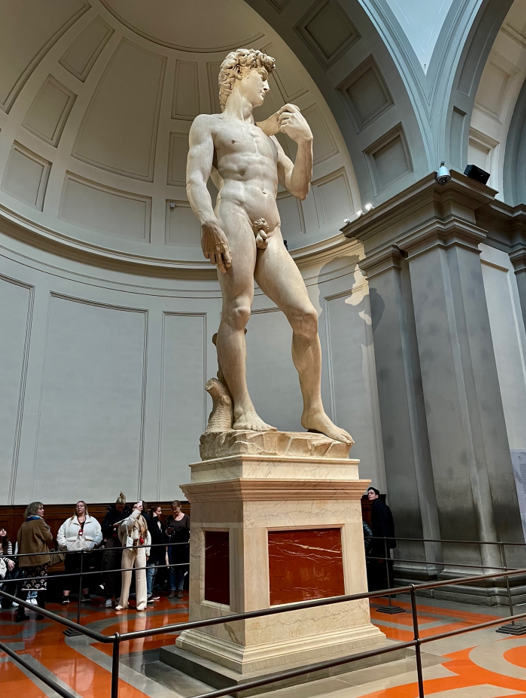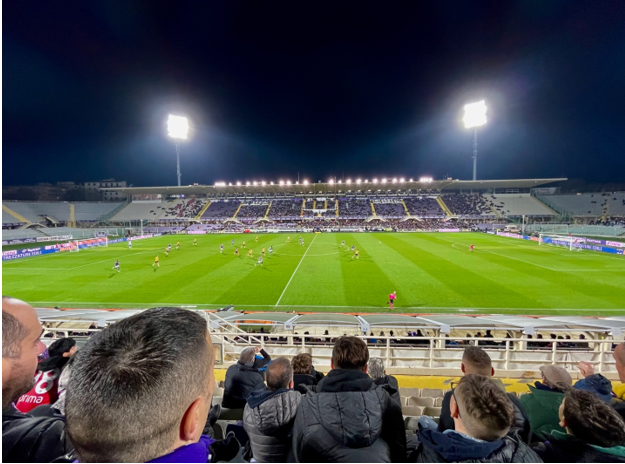The Academia and the Fiorentina Football Match: Jan Term in Italy
By Luke Roberts, ‘26, and Connor Bly, ‘26
The Academia is located less than five minutes from the duomo of Florence. It was a nice easy walk to get from our hotel to the front door of the museum. From the outside, it looks like a plain brick building and blends in with the rest of the city. Inside, however, there is a surprising amount of beautiful art.
The centerpiece in the first room is a copy of The Rape of the Sabine Women. The baroque statue depicts a woman struggling to get away from two men as a horrific event is foreshadowed. The way that the figures are positioned allows the viewer to move around the piece and view it from any angle. The three bodies twist together as they rise up to a single point. Although the statue in the academia was only a plaster replica, the real piece (in Piazza Signoria) is made from a single piece of marble. Starting the gallery with such a provocative piece stuns the guest and does a good job setting the stage for the rest of the gallery.
Down a corridor in the back of the room was a gallery filled with the instruments of Cosimo Medici. There were cases filled with instruments that looked like they would crumble at the slightest touch. String instruments, horns, flutes, harpsichords, and even an early piano! Luke thought that the instruments were a beautiful preservation of musical history.
Leading up to the David, Michelangelo’s unfinished works show the audience his style, as well as the grueling process this genius artist went through. Included in the unfinished works is a sculpture named “The Atlas”, which is nowhere near completion. Yet, the detail in the core muscles as the figure is twisting to its left is incredible. The audience can clearly see well defined muscles that make the viewer want to twist with the chiseled body in imitation. However, the piece would have a long way to go if it were to be finished, due to its lack of a head or feet. Connor finds this artist’s skill extremely impressive because despite being halfway completed, the piece is still good enough to go in a museum next to finished works.
After gazing at the David, viewers are guided to the left towards a massive room full of busts and other sculptures. Lining the walls are the busts of many powerful figures such as emperors, kings, and Greek mythological heroes. In the middle of the room sit many small and full-size sculptures depicting ancient Greek myths and some of the most influential in our society. Connor was amazed because every square inch of this enormous room was filled with a sculpture of some kind, and each individual one is created with great quality.
One of the unfinished works of Michelangelo was a pietà of Mary holding the dead body of Jesus. Although unfinished, the pose is clearly very different from the one in Saint Peter’s Basilica. First off, the duo is standing up instead of sitting. There is also another person helping Mary hold the body, something the finished work didn’t incorporate.
The paintings in the museum fell into two categories: medieval and renaissance. With the order that the works are displayed, the Academia allows viewers to observe the path from medieval art to renaissance. Art at the beginning of the museum includes images of things like Jesus being crucified, various saints, and biblically accurate angels. Luke noticed that all of these are done in the classic medieval style with distorted proportions and a very two-dimensional approach. They also all used a lot of gold and classic presentation styles like triptychs. Further on in the museum, the art maintains its subjects of Jesus, saints, and Mary but it shifts into a renaissance style. Luke noticed that these images focused on realism, depth, and the human form.
The most notable pieces of renaissance art included the Deposition of Christ with Saint John. In the Deposition of Christ with Saint John, Jesus’ descent from the cross is depicted. The scene has dramatic lighting and poses for the subjects surrounding Jesus. A figure that stands out is a man in armor kneeling in front. Luke did some research and found out that this is actually the patron that commissioned the work and paid to be put in, something that happened frequently in religious renaissance art.
The centerpiece of the Academia was deserving of all the attention. Michelangelo’s David, standing at over 17 feet high, stood at the end of a long hallway in a massive room that allowed viewers the opportunity to walk around the statue and see it from all sides. The sculpture had the classic stance of slanted hips and one foot forward. David holds a sling over one shoulder, there is a lot of debate as to whether this is depicting him before or after his battle with Goliath, Connor felt like it was before, but ultimately, it’s up to the viewer now.

Following the Academia, Luke, Connor, and 16 others got on a 15-minute train ride to the Artemio Franchi Stadium, the home of ACF Fiorentina, to see the team take on UC Sampdoria. On the walk from the train station to the stadium there was a lot of anticipation of a good time as we could hear people chatting in Italian and could see the bright lights shining just over crème walls. We proceeded to walk around the stadium for the next 15 minutes, looking for a box office to purchase tickets. Once we found this needle in the haystack building, we were able to purchase our 18 tickets and scurry back to the opposite side of the stadium that housed our entrance tunnel. Upon entering the massive stadium, everyone was free to sit and enjoy a quality game and great view with close friends.

To our right was an enormous section of Fiorentina fans that, at times, sounded like an earthquake’s roar. This was starkly contrasted by the three rows of Sampdoria fans that gave flashbacks to high school soccer with fan sections only containing a couple parents. The game started off with a flurry of attacking chances for the Fiorentina side that resulted in a 25th minute goal by Antonín Barák. Immediately after, the entire stadium (except for 3 rows, of course) was on its feet and cheering in one huge noise. After the goal, the announcer yelled “Antonín” followed by the crowd answering “Barák.” This continued a total of four more times. Stuff like that typically doesn’t happen at MLS games back in the States, so it was really interesting to see an Italian take on the celebration after a goal.
The remainder of the half was fairly even, with Sampdoria earning a couple chances of their own and Fiorentina scoring an illegal goal (offside), but at halftime the home side still had a 1-0 advantage. As soon as the second half started, the attacking chances seemed to dry up a bit as Fiorentina sat back a little more in order to preserve their 1-0 lead. Sampdoria was able to create a couple of chances, but a skill deficit kept them from getting on the score sheet. At the final whistle, the score was still 1-0 and the home team had won. As soon as the game was finished, the stadium erupted into a team song, creating a fun community environment. In similar fashion on the train ride home, we were pleasantly surprised to hear some Fiorentina fans chanting a couple of the team chants. Connor had never been to a European game before, so this much passion in person was a totally new experience for him. Reflecting on the entire experience, Connor and Luke would definitely recommend watching a European match because of the shared passion in the atmosphere. Plus, the level of soccer is much higher and can open the eyes of any spectator, while still playing the same familiar game.
